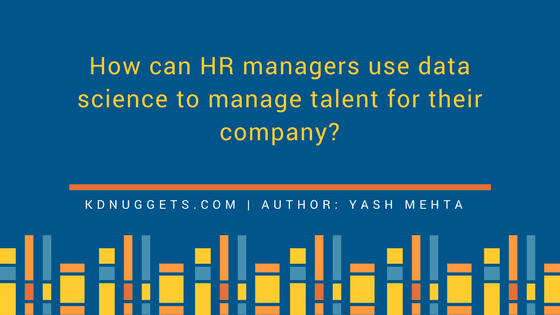How HR Managers Use Data Science to Manage Talent for Their Companies
Data sciences can also be used by HR manager to create several estimates like the investment on talent pool, cost per hire, cost on training, and cost per employee. It provides better techniques for optimization, forecasting, and reporting.
Talent acquisition may sound a minuscule term to most of us who have never been on the other side of the table. But in reality, the entire process of hiring is way too time-consuming, expensive and employs a number of resources. Hiring managers are responsible for all the hiring processes taking place in an organization. They have to devise such plans that attract a large number of eligible candidates while creating an environment where candidates would prefer to stay.

Let us point out some of the challenges faced by the hiring managers:
- Eligible Candidates: Hiring managers have the responsibility to find out the best fit for a particular position. On an average, there are around 250 resumes received for a single corporate position. If the job is posted through an online job portal then these figures scale up to around 4,27,000 resumes. These figures are just not mind-boggling but filtering candidates manually or through some filtering algorithm is another uphill task.
- Demand and Supply ratio: With increasing number of job opportunities in the market candidates have become quite selective. They have various opportunities and they can easily reject a job offer if they find something more feasible and exciting elsewhere. Hiring managers have to jot down plans and create such marketing strategies that make the candidate stay. If a selected candidate drops off then again have to repeat the complete process and find a new replacement.
- Tenuous relationship of hiring manager and recruiters: Sometimes the exact job requirements are not clearly communicated to the hiring managers. According to a survey conducted by ICIMS, 80% of recruiters think they have very good understanding of their job position while 61% of hiring managers believe that recruiters have moderate levels of understanding. This imbalance between both the parties is quite strenuous and creates a barrier for a smooth workflow.
A solution to simplify the task of staffing is through the use of data effectively according to the needs and requirements. As stated by Mike Loukides, VP, O’Reilly Media "Data scientists are involved with gathering data, massaging it into a tractable form, making it tell its story, and presenting that story to others."
How to use data sciences in the recruitment process:
- It can be used for tracking, analyzing and sharing employee related information that can be used to gain an insight into the candidate’s profile. The data is aggregated from various resources especially social media channels where candidate thoughts are left as a digital imprint and this discrete information can be analyzed and transformed into facts through various powerful algorithms.
An article on forbes.com was published where Josh Bersin explained that how a client enhanced his sales performance by $4 million in 6 months by analyzing the candidates’ data they had for several years.
- Data analytics and sciences will also help the organizations to harness the business goals more effectively and also cut down their total hiring costs. 27% employers said that a bad hiring cost them around $50000 in a year. But through data science and analytics, this cost can be reduced significantly while providing best candidates for a position.
- Data sciences can also be used by HR manager to create several estimates like the investment on talent pool, cost per hire, cost on training, and cost per employee. It provides better techniques for optimization, forecasting, and reporting.

Various forms of analytics are available and are being deployed by a number of organizations. Some of them are:
- Talent Analytics: It helps to channelize suitable talents, improvise training programs, analyze turnover, and strategies for recruitment planning and retention.
- Workforce Analytics and planning: This is another way of understanding the key needs of an organization. It deals with size, type, experience, knowledge and other such attributes that are important for enhancing the overall efficiency of an organization. This will help to maximize the throughput and ensure future business success.
- Predictive Analysis: This type of analysis is completely based on statistics and data. It helps the bosses to make plans according to available facts. A pictorial representation in the form of graphs, statistical designs are easy to comprehend and gives the leaders a clear picture of critical situations like pay gap, appraisals, resigning employees etc.
A survey conducted by IBM and MIT revealed that the organizations that employed HR analytics had positive outcomes on their business front. They saw an overall 8% increase in sales, 24% net operating income and 58% sales per employee.
Hence, we can say that switching to data science for talent acquisition is one of the essential steps for an organization in today’s time of digitalization. Though stepping in HR analytics comes with their own set of challenges that might be a bit complex and overwhelming but the results will be positive.
Bio: Yash Mehta is an Internet of Things, Big Data Science and M2M expert who is the editor-in-chief at helotechnology.com. Yash also founded an IoT software and blog named IoT Worm. You can follow him on LinkedIn, Twitter and on his personal blog yashmehta.
Related:
